Purple blooms are a favorite choice for many gardeners, ranging from light lilac to dark violet hues, and adding an enchanting element to any garden. Some of the most common purple flowers are lavender, pansies, petunias, and verbena, which provide a striking contrast when paired with light green leaves. Purple blossoms also complement white, pink, and yellow flowers, creating a harmonious blend of colors in the garden.
The color purple has long been associated with royalty, wealth, and luxury. Purple flowers symbolize success, achievement, and new beginnings, making them an ideal gift for engagements and new job positions.
To ensure your garden is filled with stunning purple blooms, it’s essential to consider a few factors. Purple flowering plants need ample sunlight to thrive, and the soil should be well-drained, not too wet or dry. With proper care and attention, your garden can be transformed into a beautiful haven of purple flowers.
Types of Purple Flowers (With Pictures and Names) – Plant Identification Guide
Read on to learn about some of the greatest and most popular flowers for your landscape. The photographs below may be used to identify the purple blooming plants.
Lavender Flowers

Lavender, a fragrant herbaceous plant that blooms during summer, is highly favored around the world. The sweet fragrance of its purple flowers is unmistakable, and the little bushy blooms, arranged on long stems, form a beautiful sea of purple.
Lavender is a versatile plant that adds beauty to any garden border, rock garden, herb garden, or container. While purple is the most common color of its blooms, some lavender varieties produce flowers that are dark red or burgundy in color. The plant can grow up to 2-3 feet (60-90 cm) tall, but container plants may be shorter.
The most remarkable feature of this bushy purple herb is undoubtedly its fragrant flowers. Lavender grows best in growing zones 5-9 and is available in various cultivars of purple lavender, including Lavandula angustifolia ‘Betty’s Blue,’ Lavenite Petite,’ ‘Melissa Lilac,’ and ‘Royal Purple.’
Lilac Flowers

Lilac (Syringa vulgaris) is a massive bush that produces cone-shaped light-purple flowers, making it one of the most sought-after blossoms in the season. The Syringa genus encompasses around 12 lilac species, each capable of reaching a height of 6 to 15 feet (2 to 10 meters).
Lilac blooms are composed of tiny purple flowers, and the bushy plant can produce blooms up to 8 inches (20 cm) in length. Despite the fact that lilac only blooms for a few weeks in spring, it adds a touch of beauty to any garden with its light purple blooms. Additionally, the cut flowers make beautiful ornamental floral arrangements.
Lilac is an excellent choice for creating a dense blooming seclusion hedge in large gardens, and dwarf purple varieties are also available. Growing zones for lilacs range from 3-7, and some popular cultivars of purple lilac include Syringa vulgaris ‘Albert F. Holden’ (with dark purple flowers), ‘Blue Skies,’ ‘Katherine Havemeyer’ (with light pink-purple blossoms), and ‘Wedgewood Blue.’
Summer Snapdragon Flowers

Angelonia, also known as Summer Snapdragons, produces tall conical blossoms that come in a variety of lilac to purple hues. This beautiful petal flower can provide stunning blooms throughout the summer season, making it a great addition to any garden. Although they are perennials, Angelonia plants can be grown as annuals, producing bushy plants that can reach a height of 3 ft (90 cm). The plant produces eye-catching purple, pink, and white flowers that are sure to add color to any garden.
The most notable feature of Angelonia is its showy blossoms, which have a lovely scent and are ideal for floral arrangements. These plants grow best in growing zones 10-11. Some popular cultivars of purple snapdragons include Angelonia ‘Angelface Blue,’ ‘Angelface Steel Blue,’ and ‘Angelface Wedgewood Blue,’ which features light-purple and white bi-colored petals.
Purple Salvia Flowers

Salvia, also known as sage, is another beloved herb with beautiful purple flowers. During late spring and early summer, this shrubby herbaceous plant produces purple blooming stalks that feature showy, tube-shaped flowers in purple or blue hues. Depending on the climate, sage may bloom all summer long. Hardy Salvia varieties can be planted as perennials, producing a lovely woody fragrance in addition to deep purple blooms. Salvia grows to a height of 1 to 3 feet (30 to 90 cm), similar to lavender.
The most remarkable feature of Salvia is its low-maintenance flowers, which are ideal for adding to floral displays. These plants are suitable for growing in zones 3-9. Some popular cultivars of purple Salvia include Salvia nemorosa ‘Amethyst’ (with pink-lavender flowers), ‘Amistad’ (featuring deep blue blooms that last all summer until frost), and Salvia farinacea ‘Victoria Blue.’
Purple Pansies
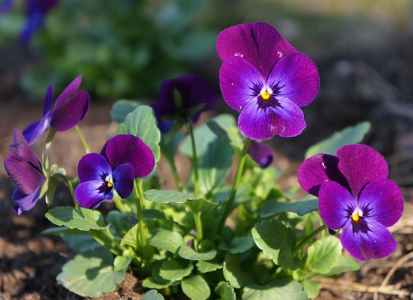
Pansies, belonging to the Viola species, offer a wide range of colors and hues that allow you to create a garden of your choice. These vibrant flowers are recognized for their striking petals, which can be monochromatic or multi-colored. For instance, some pansies have dark purple and orange petals, while others have white tones that fade to light purple over time. With a unique range of color variations, pansies bloom during the winter, spring, and summer seasons.
The most notable feature of pansies is their delicate and wonderfully fragrant flowers, which come in a range of striking colors. These flowers are easy to grow and care for and can thrive in growing zones 5-8. Some popular cultivars of purple pansies include Viola ‘Sorbet Icy Blue’ (featuring white and purple flowers), ‘Halo Lemon Frost’ (with light purple and lemon-colored petals), ‘Halo Lilac,’ and ‘Celestial Midnight’ (with dark purple petals and a striking yellow center).
Verbena
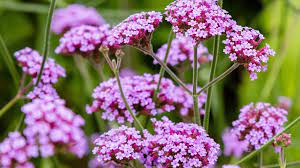
Verbena, a beautiful purple blooming plant, has delicate little petals that make it an excellent choice for summer planting. This woody plant produces little flowers from the end of spring until the first frost, with flowerheads made up of little florets in lilac, purple, pink, red, blue, or white hues. This bushy plant can spread up to 3 feet (90 cm) and reach heights of up to 1 foot (30 cm), making it an ideal ground cover with its colorful blooms.
The most remarkable feature of Verbena is its ability to supply a constant stream of flowers throughout the summer season. These plants are easy to grow and maintain and can thrive in growing zones 3-11. Some popular cultivars of purple verbena include Verbena ‘Superbena Large Lilac Blue,’ ‘Superbena Dark Blue,’ ‘Superbena Violet Ice,’ and ‘Homestead Purple.’
Purple or Blue Iris Flowers

Irises are a beautiful perennial flowering plant that produces a wide variety of flowers. These plants feature tall stems with long and slender blooms at the top. Iris flowers can have long, narrow, or oval petals, while others have wide ruffled colorful petals. For instance, Iris spuria features long thin or oval petals. The length of the iris stems can vary between 2 to 5 feet (60 to 150 cm) depending on the species. Dwarf irises are particularly attractive with their grass-like leaves and tiny purple flowers.
The most notable feature of irises is their stunning flowers, which create gorgeous displays, and a wide range of exquisite plants are available. These plants can thrive in growing zones 3-9. Some popular cultivars of purple iris include Japanese Iris ‘Frilled Enchantment’ (featuring large white ruffled petals with lilac edges), Iris hollandica ‘Blue Magic’ (with dark violet petals and bright yellow highlights), and Bearded Iris ‘Celebration Song’ (with light pink petals fading to lavender-blue colors).
Clematis

Clematis with dark purple flowers is a showstopper and is widely regarded as one of the world’s most beautiful flowers. During the summer season, you can add beauty to your yard with purple blooming Clematis vine plants. Clematis belongs to the Ranunculaceae genus, which is related to Buttercups. The diverse range of flower forms and colors in climbing plants like clematis is one of the plant’s unique features. Some examples of clematis blooms include star-shaped purple flowers with crimson stripes, papery thin petals in a bell shape, or spectacular double blooms that resemble pompoms.
The most notable feature of purple clematis is its huge blooms that brighten up your garden from early spring to late summer. These plants can thrive in growing zones 4-10. Some popular cultivars of purple clematis include Clematis ‘Arabella’ (featuring star-shaped purple flowers with a spiky white center), ‘Blue Dancer’ (with delicate light-purple petals and an early blooming period), and ‘Diamantina’ (with showy blooms featuring multiple layers of violet frilly petals).
Purple Hyacinth Flowers

Hyacinths (Hyacinthus) are known for producing stunning clusters of flowers in the spring season. These plants can grow up to 8 inches (20 cm) tall and feature a large spike of flowers. Hyacinth flowers are commonly found in pastel colors, ranging from pink to orange.
The most remarkable feature of hyacinths is their lovely group of tubular-shaped or recurved-petal blooms. These plants are suitable for growing in zones 4-8. Some popular cultivars of purple hyacinths include Hyacinthus orientalis ‘Blue Festival,’ ‘Miss Saigon’ (featuring deep violet fragrant blooms), and ‘Purple Sensation.’
Lily of the Nile
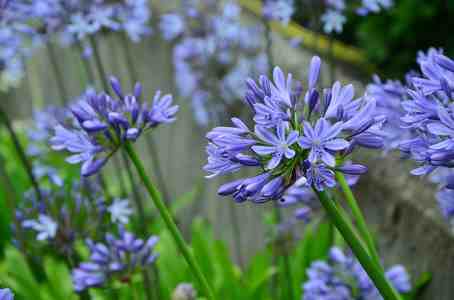
Lily of the Nile (Agapanthus praecox) is a popular flowering plant for warm climates, commonly found in gardens. These tall perennials feature attractive flowerheads at the end of their stems, which appear like an explosion of color. The flowerheads are globular and can reach up to 8 inches (20 cm) in width, consisting of tiny purple flowers. Usually, several flowering stems arise from a clump of grass-like leaves. These perennials typically bloom from the middle of summer to the beginning of fall.
The most remarkable feature of Lily of the Nile is the ability to fill your garden with purple, blue, white, and pink flowers by planting them in clusters. These plants thrive in growing zones 8-11. Some popular cultivars of purple Lily of the Nile include Agapanthus ‘Fireworks’ (with trumpet-like light purple and white flowers), ‘Silver Moon’ (featuring lavender-blue tubular flowers), African Lily ‘Purple Cloud,’ and ‘Headbourne Hybrids’ (with dark violet-blue star-shaped flowers).
Fuchsia

Fuchsia is a shrubby plant that features tiny flowers that hang from stems, and come in a variety of hues, including pink petals with a purple center. These flowers are particularly attractive due to their contrasting centerpiece, which consists of a few long petals. Fuchsia blooms also feature long stamens protruding from their centers, giving them an elegant appearance.
During the summertime, several fuchsia plants produce magnificent displays by producing double blooms. These blooms come in a wide range of colors, including purple and pink, light pink and lilac, red and mauve, and blue and white. The most remarkable feature of fuchsia plants is the gorgeous displays of blooms in a wide range of colors.
Fuchsia plants thrive in growing zones 8-9. Some popular cultivars of purple fuchsia include Fuchsia ‘Maxima,’ ‘La Campanella,’ ‘Dollar Princess,’ ‘Delta’s Sara,’ and ‘Ben Jammin.’
Purple Hydrangea Flowers

Hydrangeas are bushy plants that produce elegant flowers with huge colorful blooms that last from early spring to late autumn. These plants are known for their toughness and ability to handle a wide range of growing conditions. Hydrangea blooms can grow up to 8 inches (20 cm) across, and they are among the showiest of all flowers. Their petals come in a variety of shapes, including star-shaped, oval, and multicolored, making them truly unique. These bushy plants have a spread of about 4 feet (1.2 meters) and can reach a height of 4 feet (1.2 meters).
If you want to enjoy huge blossoms all summer, it’s best to plant hydrangeas near the borders or as a ground cover. These plants thrive in growing zones 6-9. Some popular cultivars of purple hydrangeas include Hydrangea ‘Merritt’s Supreme’ (featuring dense deep purple mophead blooms), ‘Sumida No Hanabi’ (with light purple-blue showy double florets), and ‘Hamburg’ (featuring purplish large flowerheads that turn to red).
Foxglove

Foxgloves, also known as Digitalis, are known for their striking purple blooms, making them an easy-to-spot addition to any garden. These perennial plants typically grow tall stems with numerous tubular, trumpet-shaped flowers. Foxgloves come in a range of colors and color combinations, but some of the most attractive varieties feature light purple or mauve petals with black markings. These flowers may grow to be anywhere between 2 and 5 feet (60-150 cm) long.
One outstanding feature of foxgloves is their towering height, with little bell-like flowers trailing off. These plants thrive in growing zones 4-8. Some popular cultivars of purple foxgloves include Digitalis purpurea ‘Excelsior Group’ and ‘Pam’s Choice.’
Coneflower (Echinacea)
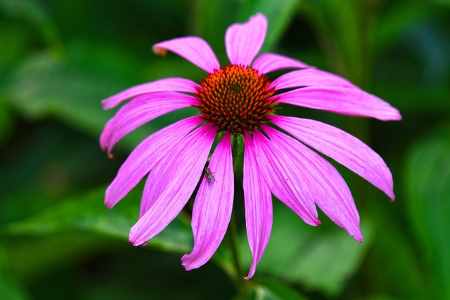
Coneflowers (Echinacea) are a popular summer-flowering plant known for their medicinal properties. These herbaceous perennials come in a variety of light purple and pink shades and can add a beautiful touch to any summer garden. The blooms are supported by long stems that range from 1 to 4 feet (30 to 120 cm) long.
The lengthy florets of the coneflower seem to be purple rays emanating from a deeper spiky ball-shaped center. Certain varieties of the flower have petals that fall down, creating a stunning visual effect. In addition to their beauty, echinacea is also known for its therapeutic and healing properties.
Outstanding feature: These plants can thrive in areas where other plants may struggle, and they produce attractive purple blooms. Growing zones: 3 – 10.
Crocus

Crocus is a perennial plant that grows from bulbs and comes in a variety of lovely colors, including purple, white, and pink. These bulbous perennials make excellent ground cover during the winter months. While crocus can be found in various colors, purple is the most common. Bi- and multi-colored purple crocus are among the most stunning. For example, light lilac petals with deep orange centers. The height of crocus is around 4 inches (10 cm).
Outstanding feature: Gorgeous blooms during the winter months. Growing zones: 3 – 8. Purple crocus cultivars: ‘Siber’s’ Crocus, Crocus sativus ‘Saffron,’ ‘Spring Beauty,’ ‘Roseus,’ ‘Whitewell Purple.’
Petunia
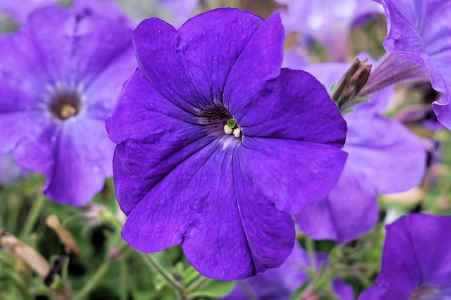
Petunias are a type of flowering plant that comes in a wide range of colors, including various shades of purple. The blooms have a trumpet-like shape and grow in a bushy pattern. Petunias are a great choice for gardens as they bloom from late spring to fall, providing beautiful floral displays for a long period.
There are many varieties of petunias, with the Grandiflora being the largest in terms of flower size. Petunias also come in a range of colors, making it possible to create stunning displays by combining different shades.
Outstanding feature: Petunias create gorgeous ground cover and are also perfect for hanging baskets and pots. Growing zones: 2 – 11. Purple petunia cultivars: ‘Shock Wave Deep Purple,’ ‘Shock Wave Denim,’ ‘Supertunia Bordeaux,’ ‘Supertunia Mulberry Charm,’ ‘Tidal Wave Purple,’ ‘Supertunia Royal Magenta.’
Speedwells

With its fuzzy spiked clusters of little flowers, speedwell is an excellent choice for those who prefer smaller flowers in their garden. Its purple blooms create an impressive display and make it stand out. Depending on the cultivar, speedwells can grow up to 10 inches to 3 feet (25 cm to 90 cm) in length. Speedwells can be used as ground cover because of their spreading ability. Additionally, their long slender spikes make them perfect for cut flower displays.
Outstanding feature: Bushy clumps of vibrant, spiked blossoms. Growing zones: 4 – 8. Purple speedwell cultivars: ‘Hocus Pocus,’ ‘Purple Illusion,’ ‘Royal Candles’ (with deep purple-blue fuzzy spikes).
Allium
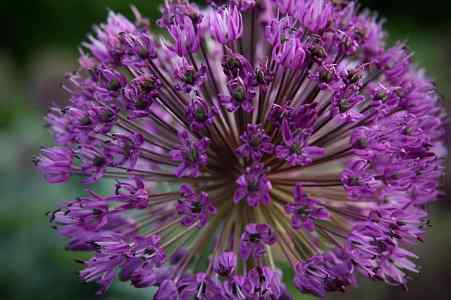
Alliums are a magnificent genus that include the ornamental flowering onion, and they are well-known for their striking purple flowers. These flowers appear in late spring or early summer, standing tall on long green stems with large spherical purple flowerheads. The large blooms of purple alliums can measure up to 10 inches (25 cm) in diameter. These violet blooms are arranged densely in globes, forming a star-like pattern. Alliums may appear in different shades of purple, such as dark purple, reddish-purple, or lilac.
Outstanding feature: Plant along borders to create a stunning effect in your garden. Growing zones: 4 – 8.
Aster

Asters are easy-to-grow summer flowers that display thin, spiky petals in shades of purple, with a bright yellow center. They are perfect for adding a pop of purple to your garden. The aster’s purple petals radiate outward from a central yellow disc, resembling a starburst. Planting a variety of asters can provide a stunning focal point in your garden during the summer. These violet blooms are easy to cultivate and bring a range of purple shades to your yard.
Outstanding feature: Spiky flowers in shades of purple, lilac, light blue, and violet. Growing zones: 5-8 Purple aster cultivars: ‘Wood’s Purple,’ ‘Grunder’ (with deep-bluish lavender petals and a yellow center), bushy ‘Sapphire’ asters, ‘Violet Queen,’ ‘Kickin Lilac Blue.’
Calla Lily

As one of the most distinctive and breathtaking flowers, Calla Lilies (Zantedeschia) are often regarded as romantic, exotic, and stylish. Some varieties of purple calla lilies are especially stunning with their pure white petals and dark violet centers, while others come in nearly black shades. These beautiful summer blooms typically grow to a height of 1 to 2 feet (30-60 cm). They can serve as a dramatic focal point in any special occasion or celebration.
Outstanding feature: Elegant trumpet-shaped blossoms that are complemented by an exquisite leaf. Growing zones: 8 – 10. Purple cultivars: Zantedeschia ‘Odessa,’ ‘Picasso,’ ‘Lavender Gem,’ ‘Night Cap.’
